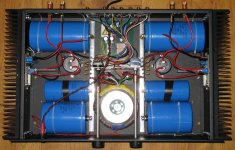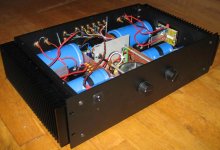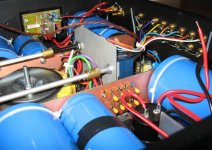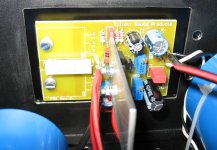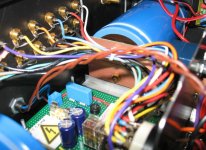So after much blood, sweat and tears my remade Death of Zen amplifier is now as good as finished. The old version didn't really deserve pictures to be posted here, but I think this one does  . I am currently in the process of fine-tuning the quiscent current and voltage at the + of C3, so I haven't really listened to it yet. Anyway, first some specs:
. I am currently in the process of fine-tuning the quiscent current and voltage at the + of C3, so I haven't really listened to it yet. Anyway, first some specs:
The transformer is a 2x25V 250VA Amplimo toroid.
Filter caps per channel are:
- Sprague Powerlytic 37000, 25000 and 20000 uF electrolythics
- 4 paires of 4u7 uF tantalum caps
- 100 uF on the PCB (C5 in Rods circuit diagram)
- 1uF MKT on the PCB
Transistors for the stages are BC559, MJE15030 and MJL4281 respectively.
The output caps are 4700uF Black Gates (I hope they'll be worth their money ).
).
Heatsinks are two 100mm Fischer SK 56s, rated at 0.4K/W (one per channel).
I built my Doz as an integrated amp, using a passive preamp (6-input rotary switch and an Alps volume pot). I also included a soft-start, to prevent fuses from blowing .
.
Please tell me what you think!
The transformer is a 2x25V 250VA Amplimo toroid.
Filter caps per channel are:
- Sprague Powerlytic 37000, 25000 and 20000 uF electrolythics
- 4 paires of 4u7 uF tantalum caps
- 100 uF on the PCB (C5 in Rods circuit diagram)
- 1uF MKT on the PCB
Transistors for the stages are BC559, MJE15030 and MJL4281 respectively.
The output caps are 4700uF Black Gates (I hope they'll be worth their money
Heatsinks are two 100mm Fischer SK 56s, rated at 0.4K/W (one per channel).
I built my Doz as an integrated amp, using a passive preamp (6-input rotary switch and an Alps volume pot). I also included a soft-start, to prevent fuses from blowing
Please tell me what you think!
Attachments
Looks solid!
Let us know how it sounds (especially with the BG output caps) after setting the bias is done. I was very happy with my DoZ but replaced it with a GC, then a sonic t-amp and finally the amp6. Maybe I should listen to it again soon just to see if that was a good decision.
Let us know how it sounds (especially with the BG output caps) after setting the bias is done. I was very happy with my DoZ but replaced it with a GC, then a sonic t-amp and finally the amp6. Maybe I should listen to it again soon just to see if that was a good decision.
paulb said:What bias current are you using, and how hot do the heatsinks get?
I'm aiming for 1.5A. At that current, the heatsinks get warm, but not too hot (I estimate they'll stay below 50C).
I can say it is a definite improvement over my previous DoZ. The sound is more defined, more detailed. Ambience is also better. And the bass seems to have slightly more presence. Last night I listened to the Dire Straits (CD: On The Night, title: Private Investigations) and I discovered new sounds I didn't know were there before, so I'm quite happy with that  . I also noticed the sound was improving as the amp heated up.
. I also noticed the sound was improving as the amp heated up.
That said, I think the bass response was still not fully there yet... don't know if it's the speakers. Could be, their -2db point is at 80Hz.
Funny thing: Sunday afternoon, while setting the bias current, I already had one channel playing (the one that was calibrated first). At that time, I thought it sounded somewhat flat and uninspiring, even though electronics had heated up at that point. That evening, I again started playing CDs (the same channel), and noticed it sounded better. Could this be because some components needed to settle or anything?
FYI: I'm testing with a Philips CD711 cd player (modded with gold-plated cinch connectors) and B&W DM14 speakers.
That said, I think the bass response was still not fully there yet... don't know if it's the speakers. Could be, their -2db point is at 80Hz.
Funny thing: Sunday afternoon, while setting the bias current, I already had one channel playing (the one that was calibrated first). At that time, I thought it sounded somewhat flat and uninspiring, even though electronics had heated up at that point. That evening, I again started playing CDs (the same channel), and noticed it sounded better. Could this be because some components needed to settle or anything?
FYI: I'm testing with a Philips CD711 cd player (modded with gold-plated cinch connectors) and B&W DM14 speakers.
lineup said:You have built with very high, almost overkill, quality.
I mean both supply and heatsinking.
Sure a very fine amp!
Congratulations!
lineup
Thanks. I know the filter caps are probably overdone, but I really wanted to "get things right" this time around
A small update:
Yesterday evening I listened to some CDs that I know very well, and I was pleasantly surprised by the sound of my amp . I felt that it sounded warmer than before. So, after that, I swithed to a CD - and a particular music fragment - I had been using for testing before. I felt that that sounded better as well.
. I felt that it sounded warmer than before. So, after that, I swithed to a CD - and a particular music fragment - I had been using for testing before. I felt that that sounded better as well.
It might just be me getting used to this amp, or actual burn-in (if such a thing exists), but I do perceive improvement. I'm curious if this will continue, and with what superb sound I will end up with .
.
Yesterday evening I listened to some CDs that I know very well, and I was pleasantly surprised by the sound of my amp
It might just be me getting used to this amp, or actual burn-in (if such a thing exists), but I do perceive improvement. I'm curious if this will continue, and with what superb sound I will end up with
Another update:
Burn-in does exist! I previously considered the possibility that it was my imagination, but now I'm sure of it. I really get the sense that I've built a high-end amplifier . I've been talking about it to someone working at the shop I bought the Black Gates from, and he said BG even specifies a burn-in period of 100 hours. I don't think I've had the amp running for that long, so it might even get better still.
. I've been talking about it to someone working at the shop I bought the Black Gates from, and he said BG even specifies a burn-in period of 100 hours. I don't think I've had the amp running for that long, so it might even get better still.
However, despite the amazing sound, there is one other problem: the amp gets hotter than I thought. With the cover removed, the temperature stabilizes. But apparently, the cover blocks too much airflow, and after a couple of hours, the amp heats up further. Guess I have to fix that, some day...
Burn-in does exist! I previously considered the possibility that it was my imagination, but now I'm sure of it. I really get the sense that I've built a high-end amplifier
However, despite the amazing sound, there is one other problem: the amp gets hotter than I thought. With the cover removed, the temperature stabilizes. But apparently, the cover blocks too much airflow, and after a couple of hours, the amp heats up further. Guess I have to fix that, some day...
AIRFLOW Chassis heatsink
yes,
of course,
good airflow is a requirement for optimal cooling
you can drill some holes in suitable place of chassis
I would make one effective air intake right under heatsink - close to
and make some air outlets
the air outlets could be in the side panels upper area or chassis back upper part
does not necessary have to be right above heatsink
this will make COLD AIR (at room temp) hit the heatsink directly
and when AIR has absorbed heat it will go out of CHASSIS, if there is such an WAY OUT, in upper part of chassis
(upper, because hotter air GOES UP)
We can use HOW BIG SINK we can
but without air flow, it is just as using smaller heatsink.
I prefer putting heatsink ON Outside of chassis.
Nelson Pass lets ALL Of The Chassis be a VERY big HEATSINK
Regarding CHASSIS Heat and how to do things
we can actually learn a little bit FROM good PC designs.
They have Air Intake (often at the power supply].
and outlets. Like those MID-Tower ATX boxes.
Except they use 12 Volt FANS to increase the air moving and the optimal AIRFLOW.
We do not want to use FANS. Not if we can avoid it!
Regards
lineup
yes,
of course,
good airflow is a requirement for optimal cooling
you can drill some holes in suitable place of chassis
I would make one effective air intake right under heatsink - close to
and make some air outlets
the air outlets could be in the side panels upper area or chassis back upper part
does not necessary have to be right above heatsink
this will make COLD AIR (at room temp) hit the heatsink directly
and when AIR has absorbed heat it will go out of CHASSIS, if there is such an WAY OUT, in upper part of chassis
(upper, because hotter air GOES UP)
We can use HOW BIG SINK we can
but without air flow, it is just as using smaller heatsink.
I prefer putting heatsink ON Outside of chassis.
Nelson Pass lets ALL Of The Chassis be a VERY big HEATSINK
Regarding CHASSIS Heat and how to do things
we can actually learn a little bit FROM good PC designs.
They have Air Intake (often at the power supply].
and outlets. Like those MID-Tower ATX boxes.
Except they use 12 Volt FANS to increase the air moving and the optimal AIRFLOW.
We do not want to use FANS. Not if we can avoid it!
Regards
lineup
- Status
- This old topic is closed. If you want to reopen this topic, contact a moderator using the "Report Post" button.
- Home
- Amplifiers
- Solid State
- Remake of my DoZ almost completed [pics]
